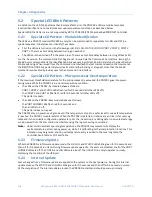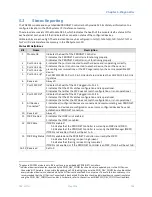
Chapter 5. Diagnostics
104
PACSystems* RX3i & RSTi-EP PROFINET IO-Controller User Manual
GFK-2571N
5.2
Special LED Blink Patterns
In addition to the LED blink patterns that indicate a fatal error, the PNC001
’s LEDs can indicate module
location/identification and microprocessor overtemperature conditions, as described below.
Special LED Blink Patterns are not supported by RSTi-EP CPE100/CPE115 embedded PROFINET Controller.
5.2.1
Special LED Pattern - Module Identification
The LEDs on a PNC001 module (PNC001-Ax only) can be commanded to repeatedly turn ON and OFF in a
special sequence, to help locate or identify the module:
•
First the LEDs are turned on in the following order:
OK, LAN, STATUS, CONFIG, PORT 4, PORT 3, PORT 2,
PORT 1
. There is a short delay between turning on each LED.
•
The LEDs are then turned off in the same order. There is a short time delay between turning off each LED.
For the -Ax version, the command,
blinkId
<begin/end> is issued via the Command Line Interface. Issuing the
blinkId begin
command starts the identification blink sequencing while the
blinkId end
stops the identification
blink sequencing. When issued from the Command Line Interface, the last command session that commands
the IDENTIFICATION blink pattern determines its state (either blinking or stopped). Note that the
blinkId
command requires Modify-level access to the Command Line Interface.
5.2.2
Special LED Pattern - Microprocessor Overtemperature
If the maximum threshold temperature for the microprocessor is exceeded, the PNC001 goes into power-
saving mode. While the PNC001 is in an overtemperature condition:
•
the LEDs on the PNC001-Ax module behave as follows:
PORT 1
,
PORT 2
, and
STATUS
LEDs flash red for 0.5 seconds (all other LEDs off),
then
PORT 3
and
PORT 4
LEDs flash red for 0.5 seconds (all other LEDs off).
This pattern repeats.
•
the LEDs on the PNC001-Bxxx module behave as follows:
the
PORT NUMBER
LEDs flash red for 3 seconds and
then all LEDs turn off.
This pattern does not repeat.
The PNC001 stays in power-saving mode until the temperature drops to a safer level. Once a safe temperature
is reached, the PNC001 module restarts. When the PNC001 is restarted, it retains any entries in its Local Log
table and its non-volatile configuration parameters. For the -Ax version, any debug data in non-volatile storage
can be viewed from the Command Line Interface using the
log
or
show log
commands.
Note:
Under certain ambient operating temperatures, the PNC001 may momentarily display the
overtemperature pattern during power up, while it is calibrating its thermal protection functions. This
indication may be ignored, and no overtemperature entry is added to the Local Log table, the
Controller Fault Table or I/O Fault Table.
5.2.3
Firmware Update
While the PNC001 is in firmware update mode, the
OK
,
LAN
, and
STATUS
LEDs blink green for 0.5 seconds and
then off for 0.5 seconds in unison. During firmware update operation, the ports are disabled, so all of the
PORT
NUMBER
LEDs are off. The
CONFIG
and
LAN
LEDs are also off. The
USB
LED (-Ax only) operates normally,
displaying the condition of the USB port.
5.2.4
Internal Update
Some changes from a firmware update are applied to the system on the next power up. During this internal
update process, the
STATUS
and
LAN
LEDs blink green for 0.5 seconds and then off for 0.5 seconds in unison.
At the completion of the internal update process, the PNC001 restarts and should power up normally.
















































